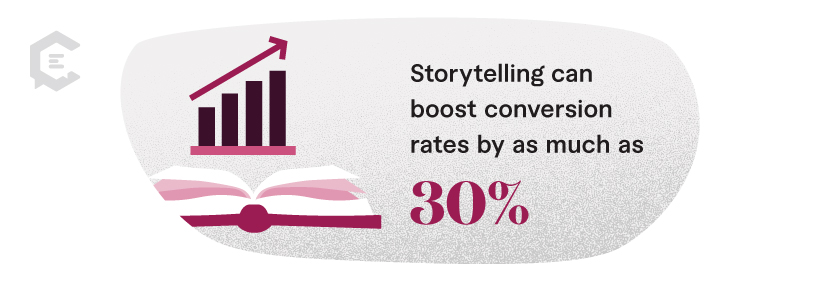There once was a marketer that churned out copy all day. Despite all their hard work, the business struggled to convert readers into clients.
If this story seems a little too familiar, you’ve come to the right place. The secret to writing winning copy is to create an emotional connection with the reader. And the most effective way to do that is through storytelling.
When people are emotionally engaged with a piece of content, they’re more likely to remember it. Harvard Business Review found that human brains naturally favor narratives, and therefore, people are more likely to respond positively to content with a storytelling component. For example, you likely empathized with the marketer’s struggle because, as a content creator, you instantly related your personal experience to their predicament.
But how do you leverage this powerful technique to create engaging and persuasive content? This article covers why investing in B2B storytelling is important to your marketing. We’ll cover strategies for incorporating storytelling, creating compelling copywriting, and avoiding common pitfalls.
The Power of Emotional Storytelling in Content Marketing
Storytelling (aka anecdote marketing) can boost conversion rates by as much as 30 percent, and 62 percent of B2B marketers consider storytelling in content marketing an effective tactic. Also, 92 percent of people prefer ads presented as a narrative, and 68 percent say brand stories influence their purchasing decisions.
To pull the right levers in B2B storytelling, you must first understand why narratives are so powerful. What will make your audience tick?
- Storytelling attracts people: We’re drawn to stories that help us connect with others, learn about their experiences, and show how they overcome challenges — that’s human nature. Storytelling in content marketing taps into this natural curiosity to help you engage with your audience at a deeper level.
- Emotions are motivating: When people engage emotionally with a piece of content, they’re more likely to remember the brand and buy more often. A study by Motista found that emotionally connected customers have a 306 percent higher lifetime value and rate brands more positively than satisfied customers.
- Stories and emotions build trust: Giving your audience a glimpse into your worldview, values, brand personality, and origin story can help you build trust and credibility with them — the key ingredient for driving conversions and improving customer loyalty.
Top Strategies For Using Storytelling in Content Marketing (and Examples)
B2B storytelling content should have a structure and a plot. Instead of being overly promotional or only focusing on information, your narrative should form personal connections with the audience by being authentic and relatable. Take the following actions to make your stories shine:
Craft Relatable Narratives
Use characters and situations that your audience can identify with. Make your ideal buyer persona the hero of your story, paint a picture of the customer journey, and show how readers can succeed by using your products or services. Shine the spotlight on your customers, and portray yourself as the partner in their success stories.
Example: Salesforce captures the reality of many click-and-mortar merchants with this client story of how Room & Board, a furniture business, created a personalized in-store shopping experience online.
Leverage Emotional Triggers
Make your content memorable and engaging by tapping into emotional triggers like fear, joy, anger, sadness, and surprise. Personal accounts and stories about individual experiences are most effective in eliciting emotions and leaving an impression on your audience. You may also add a human dimension to your brand by featuring the voices of individual employees.
Example: Microsoft’s Story Labs features the stories of its team members to show the company isn’t just a faceless corporation. The collection of narratives adds a human element to the brand, helping it to form tighter bonds with its employees and customers.
Use Visual Elements
Visual storytelling incorporates illustrations, infographics, photography, videos, etc., to connect the audience to the story. Since 65 percent of people are visual learners, adding these components can help engage your audience and keep their attention. You can also use images to provide context, illustrate complex concepts, and help readers internalize your message.
Example: Airbnb’s “Live There” campaign encouraged users to “live like a local” during their travel adventures. They implemented a strong visual storytelling campaign by featuring stunning images of Airbnb listings on Instagram shared by users, along with their stories. This created an eye-catching and visually appealing feed and fostered a sense of community among Airbnb users. That community built connections worldwide and made me people connected and, therefore, the AirBnB brand.
Mastering Sales-Oriented Copywriting
Your storytelling should go hand-in-hand with creating compelling content that inspires readers to take action. Your narrative should engage them and resonate with their needs and desires.
Here are essential tips to help you craft content that not only captures attention but also drives action:
- Understand Your Audience: Understanding your audience is foundational to the success of your content creation. You need to know where they’re coming from. What are their pain points, aspirations, and interests? Once you have a clear idea of who you’re talking to and what they need, you can tailor your content to create a personal connection by addressing those needs.
- Craft a Captivating Headline: Your headline is the gateway to your content. It should be intriguing enough to catch the reader’s eye and promising enough to compel them to read further. Use powerful words and phrases that grab your audience’s attention, evoke curiosity, or offer a solution.
- Focus on Benefits, Not Features: When writing sales-oriented content, don’t just list your product or service’s features. Highlight the benefits and show your audience how you can solve their problems and improve their lives. Benefits create a positive emotional pull, which is more effective at driving action.
- Use a Conversational Tone: Write as if you are conversing with the reader. A friendly and approachable tone makes your content more engaging and less intimidating, encouraging readers to keep reading.
- Include Storytelling Elements: See the section above this one. People love stories. Share success stories, customer testimonials, or scenarios where your product or service made a significant difference. It’s the key to making your content compelling.
- Create a Sense of Urgency: Once your narrative storytelling has hooked your audience, encourage immediate action by creating a sense of urgency. Phrases like ‘limited time offer,’ ‘exclusive deal for today only,’ or ‘while supplies last’ prompt readers to act swiftly.
- Use Clear and compelling Calls-to-Action (CTAs): To drive conversions, you need a powerful call-to-action (CTA) — but you must walk the fine line so it doesn’t feel disjointed from the narrative or appear overly promotional. For example, you can summarize the results, link the CTA back to the challenges faced by the protagonist (i.e., your ideal audience,) and end with a positive note to inspire action.
- Optimize for SEO: Do your due diligence and ensure your content is search engine optimized. Use relevant keywords, meta descriptions, and alt text for images. A strong SEO strategy will increase your content’s visibility and effectiveness.
How To Avoid Pitfalls in Content Marketing Storytelling
Successful B2B storytelling has many nuances. Here’s how to avoid some common pitfalls that could reduce the effectiveness of your narrative and undermine your credibility.
- Making your story too complicated: Don’t fall into the trap of using jargon and adding complexity since they can make your story less accessible. Remember, your goal is to build trust and connection with your audience, and simplicity and authenticity always win.
- Making your story unbelievable: Don’t embellish your narrative so much that it becomes unrealistic and unrelatable. A protagonist who’s “just like the audience” (instead of being portrayed as a superhuman) can help create more meaningful connections with the readers.
- Being too sappy: Overly sentimental content can feel fake, turn off your audience, and even impact your credibility. Strike a balance between emotion and logic by supporting your narrative with facts and statistics.
- Coming off impersonal: Don’t hide behind the corporate veil — human emotions spark imagination and inspire action. Emphasize the human angle in your stories by helping the audience connect with the protagonist and inviting them to embark on the journey of transformation together.
Drive Conversions With B2B Storytelling
Storytelling in content marketing is a powerful tool that can help brands stand out in today’s noisy marketplace. It helps you build genuine connections with your audiences, drive conversions, and improve customer retention. Persuasive and engaging narratives are a critical component of B2B content marketing. To maximize its effectiveness, you must support the big picture with a robust content plan that aligns with your overall marketing strategy.
The good news is that you don’t have to navigate the shifting trends alone. ClearVoice gives you access to a team of content experts to craft compelling narratives to increase your reach, connect with your audience, showcase your products, and drive conversions. Speak with a content strategist to see how we can help you create converting content written by industry experts.









